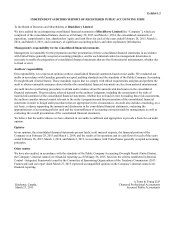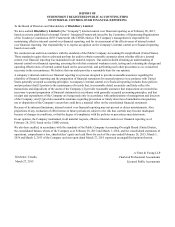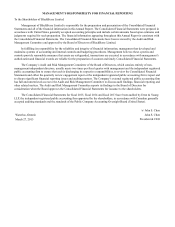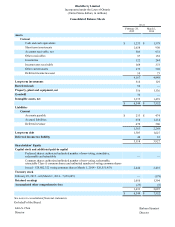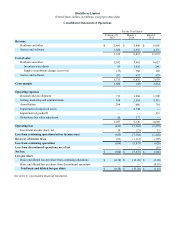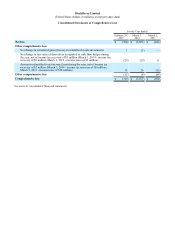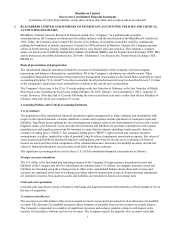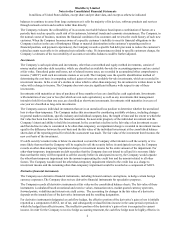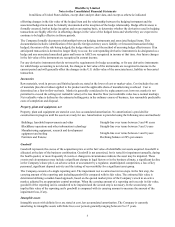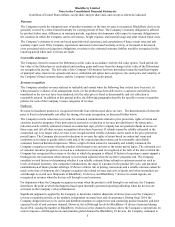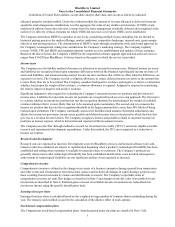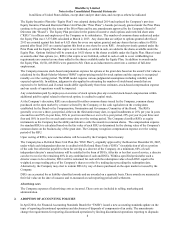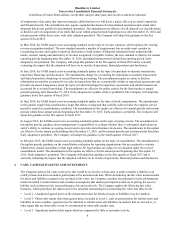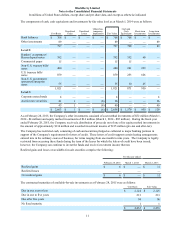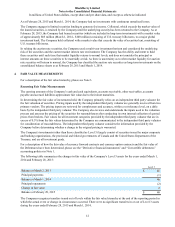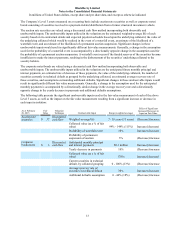Blackberry 2015 Annual Report Download - page 78
Download and view the complete annual report
Please find page 78 of the 2015 Blackberry annual report below. You can navigate through the pages in the report by either clicking on the pages listed below, or by using the keyword search tool below to find specific information within the annual report.BlackBerry Limited
Notes to the Consolidated Financial Statements
In millions of United States dollars, except share and per share data, and except as otherwise indicated
3
offsetting changes in the fair value of the hedged item and the relationship between the hedging instrument and the
associated hedged item must be formally documented at the inception of the hedge relationship. Hedge effectiveness is
formally assessed, both at hedge inception and on an ongoing basis, to determine whether the derivatives used in hedging
transactions are highly effective in offsetting changes in the value of the hedged items and whether they are expected to
continue to be highly effective in future periods.
The Company formally documents relationships between hedging instruments and associated hedged items. This
documentation includes: identification of the specific foreign currency asset, liability or forecasted transaction being
hedged; the nature of the risk being hedged; the hedge objective; and the method of assessing hedge effectiveness. If an
anticipated transaction is deemed no longer likely to occur, the corresponding derivative instrument is de-designated as a
hedge and any associated unrealized gains and losses in AOCI are recognized in income at that time. Any future changes
in the fair value of the instrument are recognized in current income.
For any derivative instruments that do not meet the requirements for hedge accounting, or for any derivative instruments
for which hedge accounting is not elected, the changes in fair value of the instruments are recognized in income in the
current period and will generally offset the changes in the U.S. dollar value of the associated asset, liability or forecasted
transaction.
Inventories
Raw materials, work in process and finished goods are stated at the lower of cost or market value. Cost includes the cost
of materials plus direct labour applied to the product and the applicable share of manufacturing overhead. Cost is
determined on a first-in-first-out basis. Market is generally considered to be replacement cost; however, market is not
permitted to exceed the ceiling (net realizable value) or be less than the floor (net realizable value less a normal markup).
Net realizable value is defined as the estimated selling price in the ordinary course of business, less reasonably predictable
costs of completion and disposal.
Property, plant and equipment, net
Property, plant and equipment are stated at cost, less accumulated amortization. No amortization is provided for
construction in progress until the assets are ready for use. Amortization is provided using the following rates and methods:
Buildings, leasehold improvements and other Straight-line over terms between 5 and 40 years
BlackBerry operations and other information technology Straight-line over terms between 3 and 5 years
Manufacturing equipment, research and development
equipment and tooling Straight-line over terms between 1 and 8 years
Furniture and fixtures Declining balance at 20% per annum
Goodwill
Goodwill represents the excess of the acquisition price over the fair value of identifiable net assets acquired. Goodwill is
allocated at the date of the business combination. Goodwill is not amortized, but is tested for impairment annually, during
the fourth quarter, or more frequently if events or changes in circumstances indicate the asset may be impaired. These
events and circumstances may include a significant change in legal factors or in the business climate, a significant decline
in the Company’s share price, an adverse action or assessment by a regulator, unanticipated competition, a loss of key
personnel, significant disposal activity and the testing of recoverability for a significant asset group.
The Company consists of a single reporting unit. The impairment test is carried out in two steps. In the first step, the
carrying amount of the reporting unit including goodwill is compared with its fair value. The estimated fair value is
determined utilizing a market-based approach, based on the quoted market price of the Company’s stock in an active
market, adjusted by an appropriate control premium. When the carrying amount of a reporting unit exceeds its fair value,
goodwill of the reporting unit is considered to be impaired and the second step is necessary. In the second step, the
implied fair value of the reporting unit's goodwill is compared with its carrying amount to measure the amount of the
impairment loss, if any.
Intangible assets
Intangible assets with definite lives are stated at cost, less accumulated amortization. The Company is currently
amortizing its intangible assets with finite lives over periods generally ranging between 2 to 17 years.


